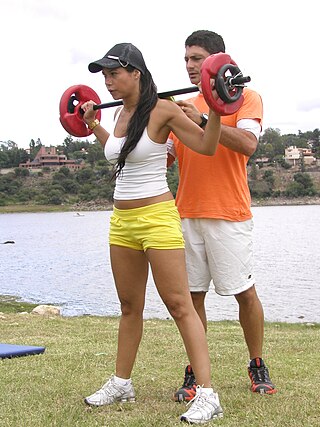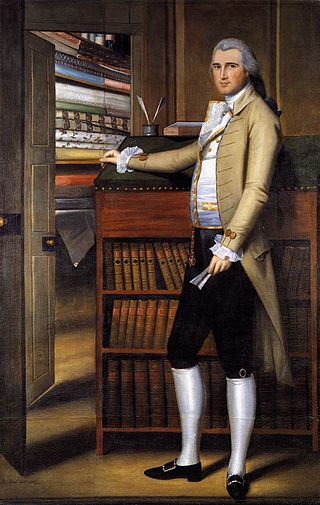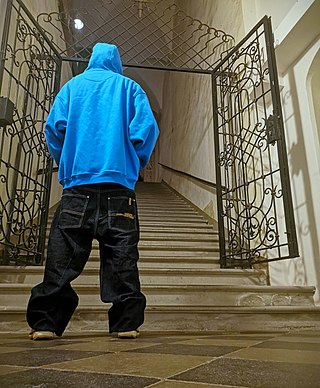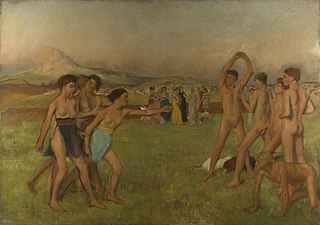
Shorts are a garment worn over the pelvic area, circling the waist and splitting to cover the upper part of the legs, sometimes extending down to the knees but not covering the entire length of the leg. They are called "shorts" because they are a shortened version of trousers, which cover the entire leg, but not the foot. Shorts are typically worn in warm weather or in an environment where comfort and airflow are more important than the protection of the legs.

Streaking is the act of running naked through a public area for publicity, as a prank, a dare, or a form of protest. Streaking is often associated with sporting events, but can occur in more secluded areas. Streakers are often pursued by sporting officials or the police.
A pub crawl is the act of visiting multiple pubs or bars in a single session.

Robert John Burck, better known as the Naked Cowboy, is an American street performer, singer, songwriter, and occasional actor. He is best known for singing regularly in New York City's Times Square. Burck is also a regular in the streets of the French Quarter during the New Orleans Mardi Gras season. He wears only cowboy boots, a hat, and white briefs, with a guitar strategically placed to give the illusion of nudity.

Breeches are an article of clothing covering the body from the waist down, with separate coverings for each leg, usually stopping just below the knee, though in some cases reaching to the ankles. Formerly a standard item of Western men's clothing, they had fallen out of use by the mid-19th century in favour of trousers.

Sagging is a manner of wearing trousers that sag so that the top of the trousers or jeans is significantly below the waist, sometimes revealing much of the wearer's underpants.

A clothing-optional bike ride is a cycling event in which nudity is permitted or expected. There are many clothing-optional cycling events around the world. Rides may be political, recreational, artistic, or a unique combination thereof. Some are used to promote topfreedom, a social movement to accord women and girls the right to be topless in public where men and boys have that right.

The Solstice Cyclists is an artistic, non-political, clothing-optional bike ride celebrating the summer solstice. It is the unofficial start of the Summer Solstice Parade & Pageant, an event produced by the Fremont Arts Council in the Fremont district of Seattle.

Ferret-legging was an endurance test or stunt in which ferrets were trapped in trousers worn by a participant. Also known as put 'em down and ferret-down-trousers, it seems to have been popular among coal miners in Yorkshire, England. Contestants put live ferrets inside their trousers; the winner is the one who is the last to release the animals.

Nude recreation consists of recreational activities which some people engage in while nude. Historically, the ancient Olympic Games were nude events. There remain some societies in Africa, Oceania, and South America that continue to engage in everyday public activities—including sports—without clothes, while in most of the world nude activities take place in either private spaces or separate clothing optional areas in public spaces. Occasional events, such as nude bike rides, may occur in public areas where nudity is not otherwise allowed.

Silliness is defined as engaging in "a ludicrous folly", showing a "lack of good sense or judgment", or "the condition of being frivolous, trivial, or superficial". In television, film, and the circus, portrayals of silliness such as exaggerated, funny behaviour are used to amuse audiences. Portrayals of silliness, provided by clowns and jesters, are also used to lift the spirits of people in hospitals.

Trousers or pants are a staple of historical and modern fashion. Throughout history, the role of trousers is a constant change for women. The first appearance of trousers in recorded history is among nomadic steppe-people in Western Europe. Steppe people were a group of nomads of various different ethnic groups that lived in the Eurasian grasslands. Archaeological evidence suggests that men and women alike wore trousers in that cultural context. However, for much of modern history, the use of trousers has been restricted to men. This norm was enforced in many regions due to social customs and laws. There are, however, many historical cases of women wearing trousers in defiance of these norms such as the 1850s women rights movement, comfort, freedom of movement, fashion, disguise, attempts to evade the gender pay gap, and attempts to establish an empowered public identity for women. Especially in the 20th and 21st centuries, the customs and laws restricting this manner of dress have relaxed dramatically, reflecting a growing acceptance and normalisation of the practice.

Trousers, slacks, or pants are an item of clothing worn from the waist to anywhere between the knees and the ankles, covering both legs separately. In the United Kingdom, the word pants generally means underwear and not trousers. Shorts are similar to trousers, but with legs that come down only to around the area of the knee, higher or lower depending on the style of the garment. To distinguish them from shorts, trousers may be called "long trousers" in certain contexts such as school uniform, where tailored shorts may be called "short trousers" in the UK.

Underwear, underclothing, or undergarments are items of clothing worn beneath outer clothes, usually in direct contact with the skin, although they may comprise more than a single layer. They serve to keep outer clothing from being soiled or damaged by bodily excretions, to lessen the friction of outerwear against the skin, to shape the body, and to provide concealment or support for parts of it. In cold weather, long underwear is sometimes worn to provide additional warmth. Special types of undergarments have religious significance. Some items of clothing are designed as undergarments, while others, such as T-shirts and certain types of shorts, are appropriate both as underwear and outerwear. If made of suitable material or textile, some underwear can serve as nightwear or swimwear, and some undergarments are intended for sexual attraction or visual appeal.

This timeline of social nudity shows the varying degrees of acceptance given to the naked human body by diverse cultures throughout history. The events listed here demonstrate how various societies have shifted between strict and lax clothing standards, how nudity has played a part in social movements and protest, and how the nude human body is accepted in the public sphere.
Improv in Toronto (IT) is an urban pranking group that resides in Toronto. Formed in 2008, Improv Toronto is a group inspired by New York City's Improv Everywhere, and is a member of the Urban Prankster Network.

The thong is a garment generally used as either underwear or in some countries, as a swimsuit. It may also be worn for traditional ceremonies or competitions.

Wearing underwear as outerwear is a fashion trend popularized by celebrities, sports and media. It began as a practical and comfortable variation of clothing, such as the T-shirt and the sleeveless shirt, but later evolved into provocative, controversial fashion statements. 21st century versions include the display of thongs and bras in women's clothing, and the display of underpants under low-slung pants in men. Wearing underwear as outerwear has historical antecedents in the display of undergarments in the sixteenth and seventeenth centuries.

An Undie Run is an event where a large number of people disrobe until they are only wearing underwear, and then run. The site of Undie Runs are typically college campuses, but they may occur on other sites such as streets. Undie Runs may be purely for entertainment, a form of protest, or as with the ASU Undie Run, fund-raising for charitable purposes. It is reported that the Guinness Book of World Records considers the Undie Run that took place on September 24, 2011, in Salt Lake City, Utah, United States to have had a record number of participants. There were 2,270 participants in that Undie Run, which was held to protest Utah's conservative laws. COED Magazine, a magazine in the United States marketed to college students, has reported that Undie Runs are the "number one university sanctioned event".
No Pants Day is an annual event in various countries that became more widely celebrated in the 2000s. It is most often observed on the first Friday in May and involves publicly wearing only undergarments on the lower part of the body, not nudity. Except for making people laugh, the holiday typically serves no other purpose or agenda, but some organizers later used it to raise social issues.


















